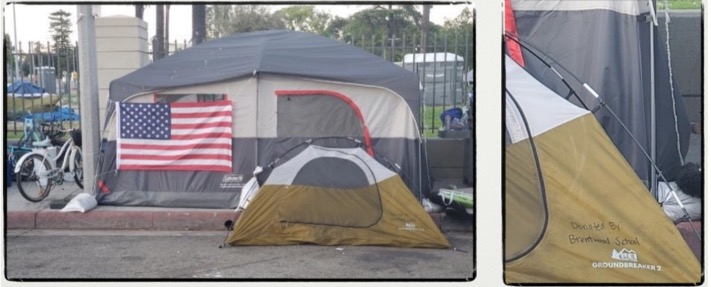CommentsVETERAN HOUSING - The sprawling 388-acre West Los Angeles Veterans Affairs (VA) Campus, deeded to veterans in 1888 as the “National Home for Disabled Soldiers,” contains 140 “Tiny Home” shelters.
These 8×8 ft. temporary dwellings are the latest flawed interim solution to the Department of Veterans Affairs’ inability to build permanent supportive housing for unhoused veterans. In the 2015 Valentini v. Shinseki class action lawsuit, the VA vowed to end veteran homelessness and stop the illegal leasing of its land to commercial interests. After the suit, the VA promised to build 1,200 units of housing for veterans. Instead, veterans have again been displaced, tiny home shelters sit vacant, and long waitlists persist for other interim services on the campus.
The Care, Treatment, and Rehabilitative Services program (CTRS) started in 2020, after veterans and advocates returned to the courtroom of Judge Otero — the judge who had presided over the Valentini v. Shinseki lawsuit — to argue that the VA had not abided by the earlier class action settlement to provide housing. A minor concession was offered by the VA, and CTRS was established. As a result, unhoused veterans were allowed to set up three-foot high pup tents in a small asphalt area on the VA campus.
CTRS started construction of pallet shelter tiny homes — each unit costs about $10,000 to build — in October 2021, after the program was pressured to accommodate the veterans who were living on “Veteran’s Row,” an encampment previously located on San Vicente Boulevard along the very gate dividing the deeded soldiers’ home from the sidewalk. The Veteran’s Row community peaked at around 53 residents. Most of the veterans living on the row were disabled, and physically unable to live in the three-foot-high pup tents. Veterans in wheelchairs, for example, could not live at the CTRS site due to the size of the tents.
Jessica Miles, an army veteran and resident of CTRS, says that, as opposed to the tiny homes’ relative permanence, “the tents at CTRS were a good gesture because they were temporary… [tiny homes] are supposed to be a stepping stone.” But Miles says that she sees veterans go into apartments with virtually zero support or wraparound services, sometimes resulting in their deaths. Miles says, “This place doesn’t make you feel productive,” and feels participants need to be better equipped with mental health support to survive.

A pup tent in comparison to Veteran’s Row tents CTRS would not accommodate. (Source: Anonymous)
When services on the campus were cut in half during the pandemic, the VA stopped admitting new veteran participants, and forced more veterans to the streets. The pandemic perpetuated a pattern of arbitrary lockdowns and inconsistent services and programs that contributed to the population growth on Veteran’s Row. While the VA put social distancing measures in place throughout the pandemic, a veteran source told Knock LA that COVID precautions were merely used as an excuse to turn away participants from programs.
In 2021, two people living on Veteran’s Row died after being denied services from the West LA VA for months. After pressure mounted from nearby Brentwood residents to sweep the sidewalk of visible homelessness, the Los Angeles County Sheriff’s Department and Los Angeles County Public Works forcibly evicted people living on Veteran’s Row in November 2021.
(Jamie Feiler and Jon Peltz are writers for Knock-LA where this story was featured.)
















